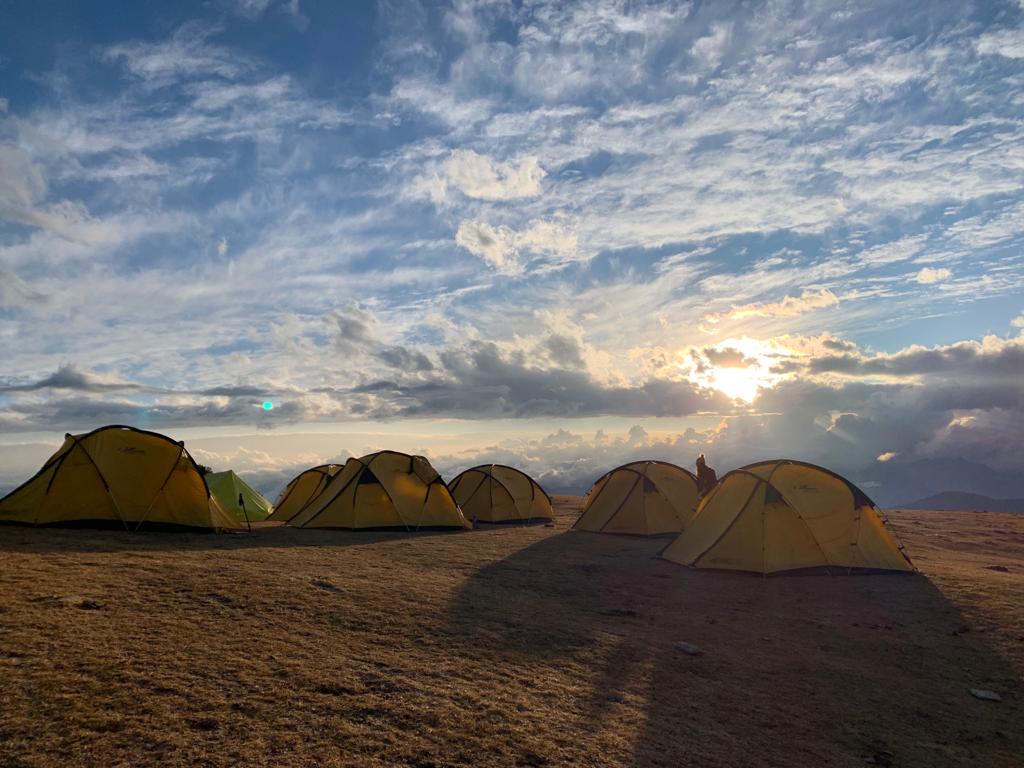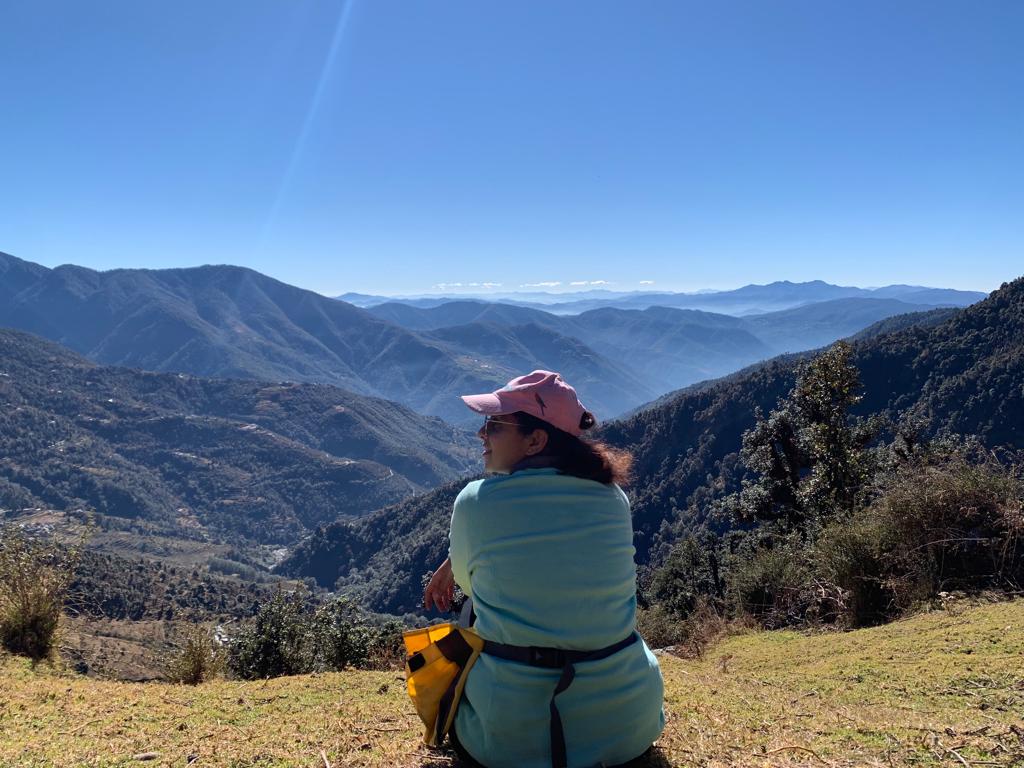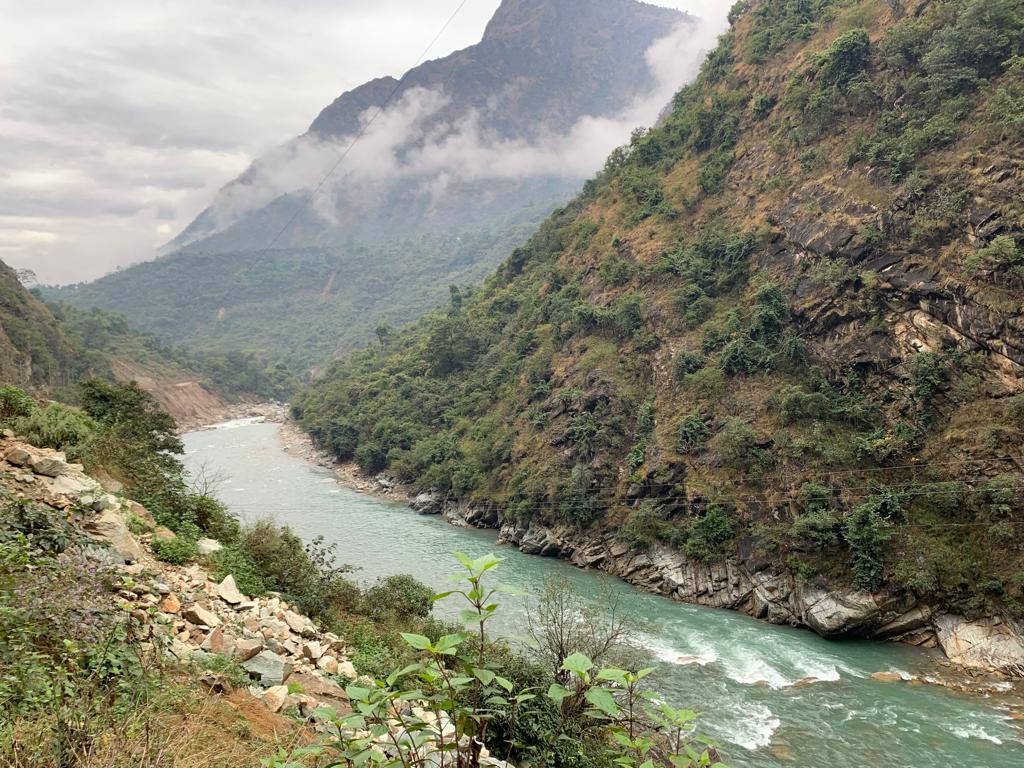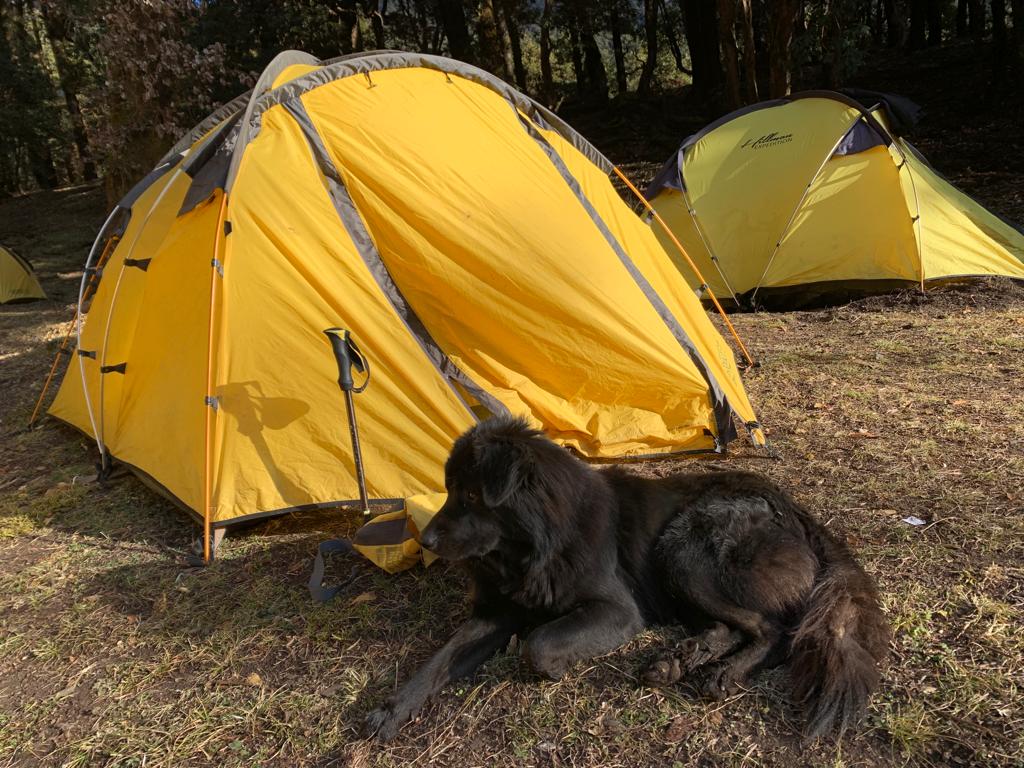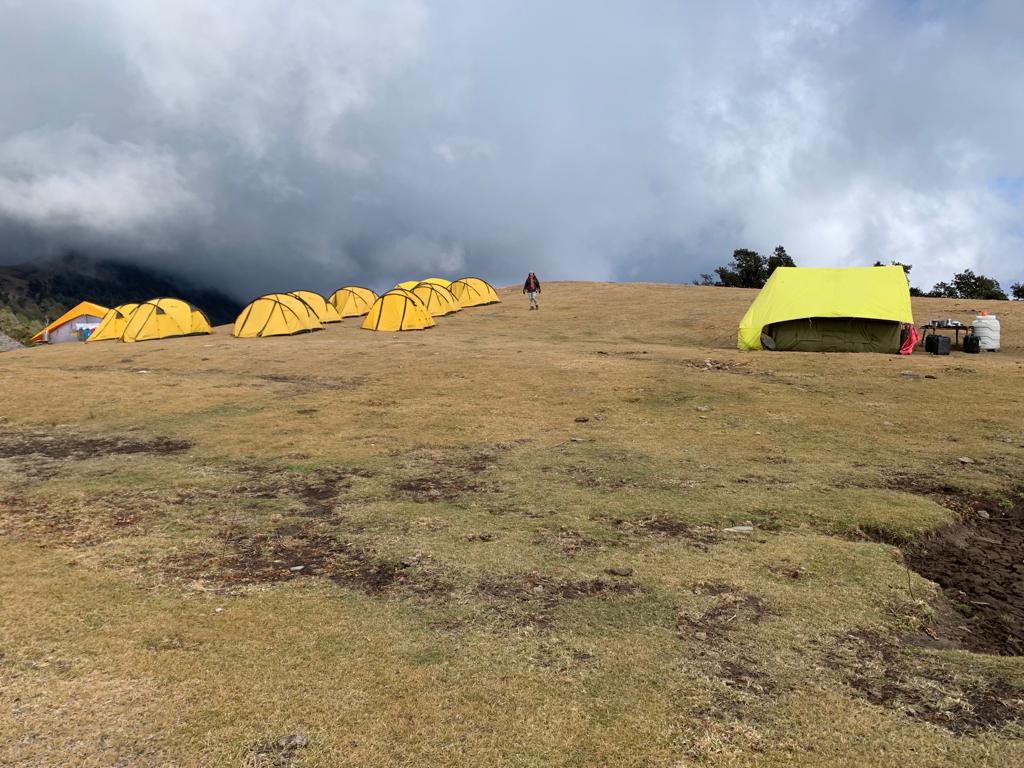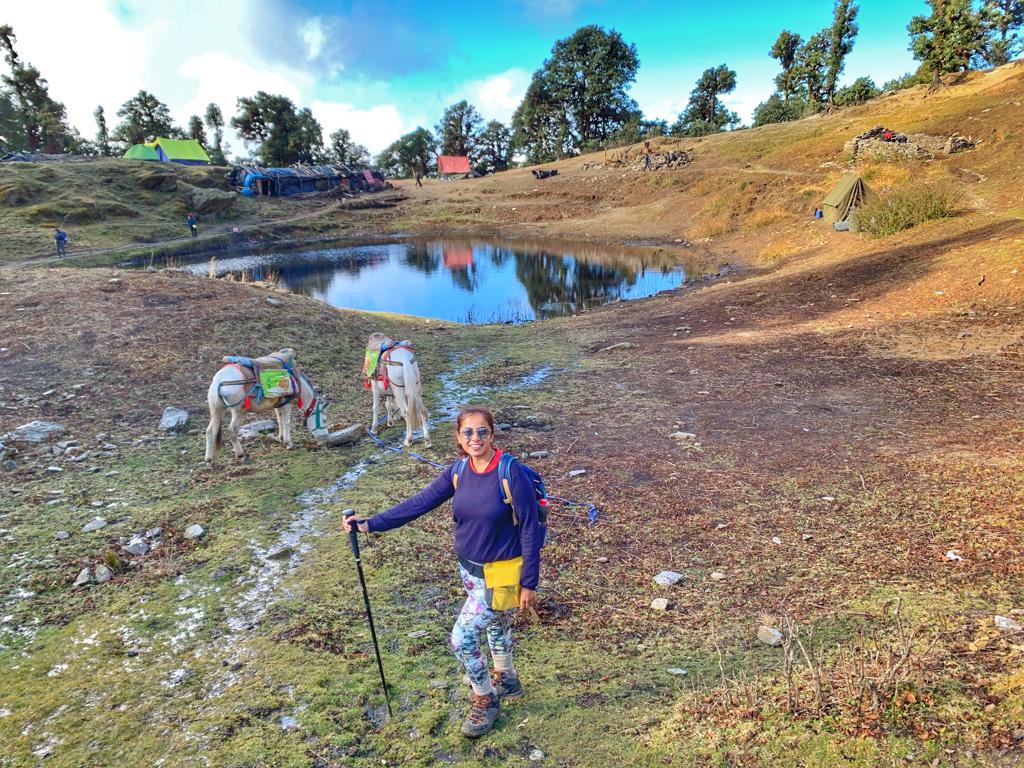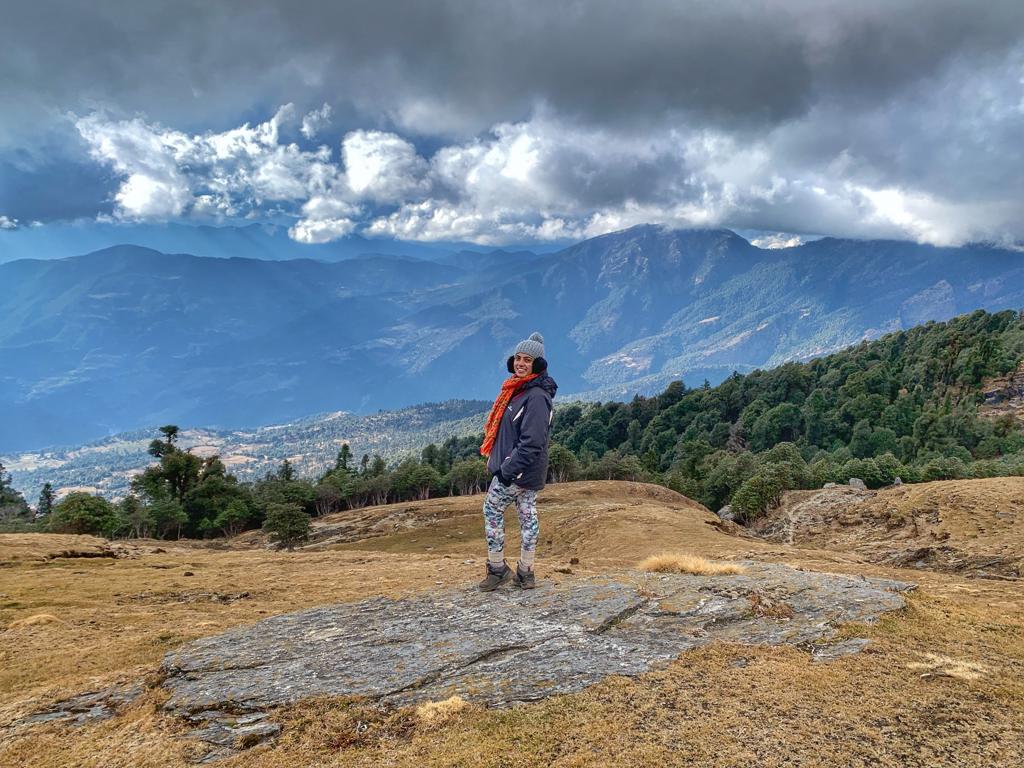Brahmatal Winter Trek in Uttarakhand – Complete Guide (2024)
Explore the mesmerizing beauty of the Himalayas on the Brahmatal Winter Trek. Immerse yourself in the pristine snow-covered landscapes and breathtaking vistas as you trek through dense forests, frozen lakes, and panoramic mountain views. Experience the thrill of camping in the snow and witness the serene beauty of the Himalayan peaks.
The majestic Himalayas beckon to every trekker, offering a paradise of adventure and beauty. Eager to immerse myself in their splendour, I repeatedly find myself drawn to these towering peaks. Fuelled by my passion for exploration, I set my sights on the Brahmatal trek, venturing into its wintry embrace to discover its wonders firsthand.
Also, Read – In the Himalayas, I have done the 11-day Trek to the Saurkundi Pass, a trek to Vaishnodevi shrine, Kashmir Great Lakes (KGL), Gurez Valley Trek, and Everest Base Camp.
Page Contents
PIN for later reference – Brahmatal Winter Trek in Uttarakhand
This article may contain affiliate links, meaning if you decide to purchase via my links, I may earn a commission at no additional cost to you. For complete information, please see our affiliate disclaimer here.
About Brahmatal Trek
Regarded as a premier winter trekking destination in Uttarakhand, the Brahmatal trek holds a special allure for novice Himalayan adventurers. Paying homage to Lord Brahma, this captivating 6-day journey commences from the quaint town of Lohajung in Uttarakhand.
The Brahmatal trek elevates adventurers to 12,260 feet (3,734 meters), treating them to breathtaking panoramas of Mount Nanda Ghunti and Mount Trishul along its winding paths. Journeying through ancient oak forests, this Himalayan expedition unveils the tranquil beauty of an alpine lake, a rare gem amidst the rugged terrain.
- Maximum Height: Summit peaks at 12,260 feet, while Brahmatal Lake rests at 10,200 feet.
- Trail: Lohajung – Gujreni campsite – Thilandi campsite – Summit – Brahmatal campsite – Lohajung.
- Nature of the Trail: Enveloped in old oak forests, adorned with snow during winter, and marked by clear, well-defined pathways.
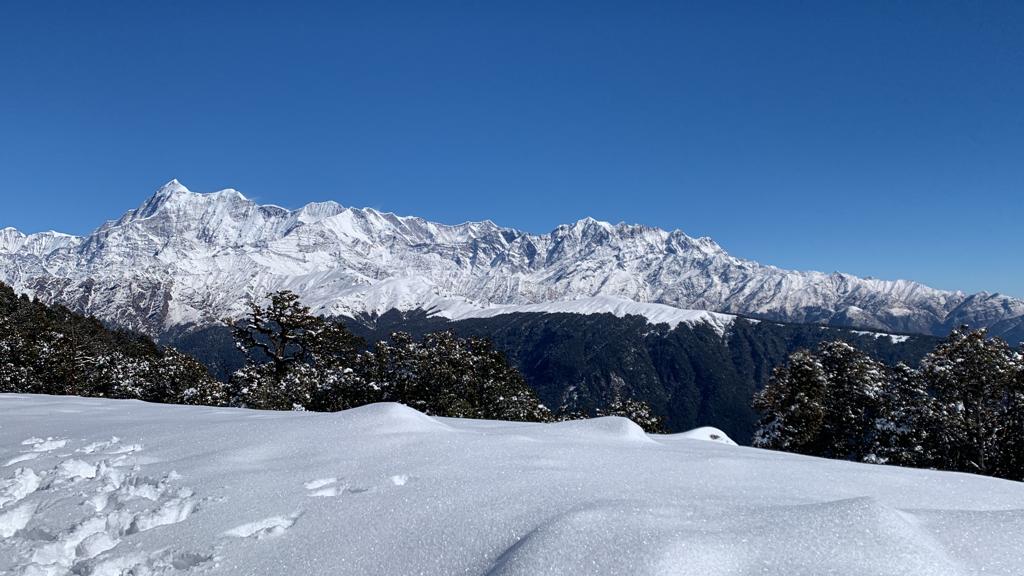
Trekking Agency
Having followed India Hikes on social media for some time, I opted to join them for the trek. Despite encountering a few initial challenges from miscommunications or last-minute adjustments communicated by the trek organizer, I ultimately had a fulfilling experience. The treks were meticulously organized, with a strong emphasis on safety being their foremost concern.
Frequently Asked Questions About Brahmatal Trek
Note: The responses to these questions are primarily based on the actions and practices observed during my trek with the chosen trekking agency.
How Many Days is the Trek?
The Brahmatal trek spans six days, with actual trekking activities taking place over four days (2.5 days ascent and 1.5 days descent).
What is the Fitness Level Required for the Trail?
Given its high altitude nature, the trail requires a reasonable fitness level. While suitable for beginners, adequate preparation and adherence to a fitness regimen are crucial before embarking on the trek. Additionally, individuals with pre-existing medical conditions should seek advice from their healthcare provider before undertaking the journey.
Where is the Starting Point of the Trek?
The starting point of the trek is the quaint town of Lohajung, situated at an elevation of 7,000 feet. The trekking agency offers optional pick-up and drop-off services from Rishikesh for an additional fee (approximately INR 1300 per person). Accommodation at the Lohajung Lodge is included in the overall trekking package provided by the agency.
What are the Statistics of the Trek?
- Starting and Finishing Points: Lohajung town in Uttarakhand.
- Total Distance: Around 30 kilometres return.
- Time Required: 4 days return.
- Grade: Moderate.
What is the Brahmatal Winter Trek Itinerary?
Day 1 – Rishikesh to Lohajung
We spent the entire day travelling from Rishikesh to Lohajung in a tempo traveller, navigating winding roads that meandered along the mountains and valleys. Those prone to motion sickness should consider taking appropriate medication beforehand.
Throughout the journey, numerous roadside dhabas are offering a variety of food options. However, please note that any food purchased en route is an additional expense.
Day 2 – Lohajung to Gujreni Campsite
Day 2 marks the official beginning of the trek. Following breakfast in Lohajung, trekkers journey towards the Gujreni campsite—the trail winds entirely through the forest, offering a serene natural setting.
Starting from Lohajung at 7,000 feet, the trek ascends to the Gujreni campsite at 9,200 feet, gaining an elevation of 2,200 feet along a distance of approximately 5 kilometres. The trek typically spans the entire morning, with trekkers arriving at the campsite before lunchtime.
- Lohajung (at 7000 feet) to Gujreni campsite (at 9200 feet).
- Elevation Gained: 2200 feet.
- Distance: Around 5 kilometres.
- Time Required: You will reach the campsite before lunch.
- Grade: Easy.
Rated as an easy grade, this journey segment offers a gentle introduction to the trekking experience.
Mountain dogs in the Himalayas are beloved companions, offering guidance and unwavering companionship throughout your journey.
Day 3 – Gujreni Campsite to Thilandi Campsite
Day 3 sees trekkers progressing from the Gujreri campsite to the Thilandi campsite via Bekaltal.
Starting at Gujreri campsite at an elevation of 9,200 feet, the trek ascends to the Thilandi campsite at 11,120 feet, gaining 2,000 feet. Covering a distance of approximately 6 to 7 kilometres, trekkers typically arrive at the campsite in time for lunch.
- Gujreni campsite (at 9200 feet) to Thilandi campsite (at 11120 feet) via Bekaltal.
- Elevation Gained: 2000 feet.
- Distance: Around 6 to 7 kilometres.
- Time Required: You will reach the campsite for lunch.
- Grade: Easy.
This leg of the journey maintains an easy grade, offering a pleasant and manageable trekking experience.
Day 4 – Thilandi Campsite to Brahmatal Campsite via the Summit
Day 4 presents one of the trek’s most challenging and demanding stretches. It involves covering a longer distance as trekkers make their way to the Summit before descending to the Brahmatal campsite.
Commencing from the Thilandi campsite at 11,200 feet, the journey proceeds to the Brahmatal campsite at 10,200 feet via the Summit, reaching 12,250 feet. This leg of the trek entails gaining 1,050 feet in elevation and descending 1,950 feet.
Spanning approximately 7 to 8 kilometres, the trek typically begins early in the morning and continues until after lunch. Please note that an early start is necessary for this leg of the journey.
- Thilandi campsite (11200 feet) to Brahmatal campsite (at 10200 feet) via The Summit (at 12250 feet).
- Elevation Gained and Lost: 1050 feet gained and 1950 feet lost.
- Distance: Around 7 to 8 kilometres.
- Time Required: Early morning to after lunch. Note that the start of the day is very early.
- Grade: Moderate to Hard.
This day, rated as moderate to hard, requires a higher level of physical exertion and stamina.
Day 5 – Brahmatal Campsite to Lohajung
The final day marks the return to the base camp at Lohajung, concluding the trekking adventure.
From the Brahmatal campsite at 10,200 feet, trekkers descend to Lohajung at 7,000 feet, with an elevation loss of 3,200 feet. Covering a distance of approximately 10 kilometres, the journey typically extends into the evening, with packed lunch provided en route.
- Brahmatal campsite (at 10200 feet) to Lohajung (7000 feet).
- Elevation Lost: 3200 feet.
- Distance: Around 10 kilometres.
- Time Required: Evening. Lunch (packed lunch) is on the way.
- Grade: Hard, especially during winter and rainy seasons, as the slopes are very slippery.
Rated as hard, particularly during winter and rainy seasons due to slippery slopes, this leg of the trek demands extra caution and perseverance from trekkers.
Day 6 – Lohajung to Rishikesh
The final day is dedicated to the return journey back to Rishikesh. Trekkers can extend their stay in Rishikesh for an additional cost. During my stay, I opted for the Live Free Hostel, which the trekking agency recommended.
The hostels in Rishikesh offer excellent accommodation options with a relaxed and vibrant atmosphere. They provide the perfect setting to unwind and connect with fellow travellers, fostering a sense of camaraderie and friendship.
Which is the Best Season to do the Brahmatal Trek?
The Brahmatal trek offers distinct experiences depending on the season you embark on the adventure.
Winter season (December to February) showcases the trek at its most enchanting, with snow-capped peaks and trails blanketed in pristine snow. However, brace yourself for freezing weather during this time.
Spring season (March to May) unveils a breathtaking landscape adorned with vibrant rhododendron flowers, painting the trail in hues of pink and red, creating a picturesque setting.
The Autumn season (September to November) treats trekkers to crisp, chilly weather and awe-inspiring views of snow-capped mountains, making it another favourable time to undertake the trek.
Conversely, it’s not recommended to attempt the trek during the summer months (June to August) and the rainy season due to unfavourable weather conditions.
What to Pack for the Trek?
Make sure to bring along an additional bag to store items and clothing not needed for the trail at Lohajung. Additionally, if you’re offloading your backpack, carrying a daypack for essentials during the trek is advisable.
Backpack
Sleeping Bag: The trekking agency provides a sleeping bag each night, but during winter, I carried my own for added warmth.
Inner Blanket: Provided by the trekking agency, this liner is used in the sleeping bag daily.
Clothing:
- Hiking T-shirts: 3 pairs
- Hiking Pants: 2 pairs
- Breathable Underwear: Clean pairs for each day plus two extra
- Thermal Top and Pants: 1 to 2 pairs
- Sweater: 1
- Fleece Jacket: 1
- Hiking Socks: 1 pair for each day plus two extra
- Woollen Socks for the night: 1 pair
- Night Clothes: 1 pair with a sweater
Footwear and Accessories:
- Flip Flops
- Lunch Box (secure)
- Mug
- Toilet Rolls
- Deodorant (travel size)
- Eco-Friendly Paper Soaps
- Toothpaste, Toothbrush, and Tongue Cleaner
- Safety Pins
- Personal Medications, including Diamox
- Power Bank and Charging Cord
- Water Purification Tablets
- Rain Cover
- Whistle
- Matchbox
These essentials ensure a comfortable and safe trekking experience while adequately preparing for varying weather conditions and terrain challenges.
Daypack
Essential Items for the Trek:
- Refillable Water Bottle
- Emergency Thermal Blanket
- Eco-Friendly Paper Soaps
- Headlamp with Extra Batteries
- Trail Snacks (Dry Fruits, Chocolates, Biscuits)
- First Aid Kit and Personal Medications
- Rain Cover
- Cash
- Poncho/Rain Coat
- Fleece Jacket
- Beanie and Balaclava
- Hand Gloves (Inner and Outer, Waterproof)
- Sun Protection Cap
- Sunglasses and Sunscreen
- Chapstick
- Hand Sanitizer
- Safety Pins
- Camera (Optional)
These items ensure preparedness for various situations and challenges during the trek, keeping you comfortable and safe throughout the journey.
Other Things Required for the Trail
- Trekking Shoes: A sturdy and comfortable pair of trekking shoes is essential for navigating varied terrain with ease and stability.
- Trekking Poles: Trekking poles provide added support and balance, especially on uneven or steep trails, reducing knee strain and improving overall stability.
How Many Layers of Clothes do I need?
I recommend layering up with five layers of clothing for evening and nighttime at the campsites to combat the rapid temperature drop after sunset. Start with thermals as the base layer, followed by a T-shirt, sweater, fleece jacket, and finally, a padded or down jacket for added warmth.
During the trek itself, you won’t require as many layers. A T-shirt paired with a fleece jacket should suffice to keep you comfortable while on the move.
Ensure to cover your neck, ears and head at all times, including when trekking.
Do we need to Carry our Backpack throughout the Trek?
You can have your backpacks offloaded, with ponies carrying them at an additional INR 250 per day per person. If you opt for this service, having a day pack for the trail is essential.
How much did the Trek Cost?
Note: My expenses are based on travelling from Bangalore.
Trek Charges: INR 10,309.
Additional Expenses:
- Backpack Offload Option: INR 1,000.
- Transportation between Rishikesh and Lohajung: INR 2,600 per person (round trip).
- Flight Charges between Bangalore and Delhi: INR 8,500 for a return trip.
- Bus Charges between Delhi and Rishikesh: INR 1,200 for a return trip.
- Stay at Rishikesh: INR 1,500 for a private room.
- Taxi Charges and Miscellaneous: INR 2,000.
Total – INR 27109 per person.
Is there any Wildlife on the Trail?
Indeed, the trail boasts abundant wildlife encounters. We had a thrilling encounter with a bear during our last trekking day. While the bear pursued one of our fellow trekkers, our group’s unity and loud presence deterred the bear, prompting it to retreat with a formidable roar.
Additionally, at the Thilandi campsite, we were treated to the majestic sight of a Himalayan Griffon vulture, adding a fascinating touch to our adventure.
How are the Toilets at the Campsites and on the Trails?
Dry toilets are utilized at the campsites, featuring a pit covered by standing tents. Instead of water, sand dust is used to cover waste, with strict instructions to avoid water or wet tissues, relying solely on toilet paper.
During the trails, nature serves as the restroom, with the wild behind the trees serving as facilities. While this lack of commercialization preserves the trail’s natural charm, it also means no tea houses or toilets along the way.
How was the food provided by India Hikes?
The food experience during the trek was truly outstanding, and it was one of the main reasons I chose India Hikes for this journey. Every meal was served fresh and piping hot, leaving a lasting impression. A highlight of the culinary delights was when we were treated to hot and delicious gulab jamuns at the Brahmatal campsite.
What was the Paperwork Required?
The Brahmatal trek necessitated some paperwork to be completed before the journey:
- Medical Certificate: Signed by a physician, detailing any pre-existing medical conditions and blood pressure readings.
- Waiver Form: Signed by all participants, acknowledging the risks involved in the trek.
- Proof of COVID Vaccination: Certifying completion of both vaccine doses.
- Proof of Identification: Valid ID for verification purposes.
- Pre-filled Interstate COVID Pass: Required by the Uttarakhand government for entry into the state.
If you have a pre-existing medical condition, it’s imperative to consult your doctor before embarking on the trek.
Lessons Learned
- When opting for interstate buses, it’s advisable to choose government-operated services for their reliability and minimal risk of cancellations. For travel to Uttarakhand, consider utilizing the Uttarakhand Transport Corporation buses.
- For flights, complete the pre-check-in process and have all necessary documents readily available. Given the rapidly changing circumstances, stay updated on interstate travel regulations.
- Select dry-fit clothing for the trek, and prioritize trek pants with pockets for conveniently stashing your phone and trail snacks.
- Layering clothing allows for easy adjustment to changing temperatures during the trek.
- Even with a rain cover for your backpack, safeguard your clothes and electronics by storing them in additional carry bags for extra protection.
- Pack one or two pairs of warm socks specifically for the chilly nights.
- Consider bringing hand warmers for comfort in cold conditions, readily available at stores like Decathlon.
- Include extra shoe laces in your gear for unforeseen circumstances.
- If you lack adequate gear, consider renting high-quality equipment from the trekking agency.
- Carry some cash for purchasing refreshments at dhabas along the trail.
- Keep headlamps easily accessible for navigating in low-light conditions.
- Trekking poles offer valuable support and stability during the trek.
- Maintain a steady and cautious pace on the trail, prioritizing safety over speed and taking small, deliberate steps.
How to Get to Rishikesh?
By Air
Rishikesh does not have an airport; the nearest one is in Dehradun. If you’re travelling solo, I recommend flying to Dehradun and taking a bus to Rishikesh. Indigo and Air Vistara are two airline providers that operate flights between major cities and Delhi/Dehradun.
By Road
The distance from Dehradun to Rishikesh is approximately 50 kilometres, with a travel time of about an hour by road.
From Delhi to Rishikesh, the distance is roughly 250 kilometres, and the journey typically takes 4 to 5 hours by car.
By Public Transport
Bus
The most reliable way to travel from Delhi to Rishikesh is by bus, with the journey typically taking around 5 hours by road.
Avoid booking private buses, as they often cancel at the last minute. I experienced this firsthand when a bus scheduled to depart at 8 PM was cancelled at 6:30 PM. Left without alternative transportation, I had to settle for a local red-coloured bus with uncomfortable seats.
For those travelling between Dehradun and Delhi, numerous frequent buses are available, lasting just over an hour.
Refer to the Uttarakhand Transport Corporation for buses.
Train
Travelers can take a train from Delhi to Haridwar, where they can transfer to a bus bound for Rishikesh.
Similarly, one can catch a train from Dehradun to Haridwar and then continue to Rishikesh. This entire journey typically lasts around 3 hours and 30 minutes.
For the latest train schedules and information, it’s advisable to consult the IRCTC website.
Is Brahmatal Trek Safe for Solo Female Trekkers?
Generally, trekking is safest with a trekking buddy or through a reputable trekking agency. I highly recommend against attempting this trek independently or even with your group without the assistance of a local guide. The trekking agency I chose was particularly adept at catering to solo female trekkers, ensuring a safe and enjoyable experience.
Download the Emergency Plus app for any unforeseen situations. The app does not require a mobile network; it shows your location. This is useful to inform the emergency services in case of any emergency.
If you are a tourist, always have good comprehensive travel insurance to cover yourself in case of any emergency.
Closing Notes
Trekking in the Himalayas becomes an addiction, with each journey leaving an indelible mark on your soul. The breathtaking scenery, the camaraderie shared with fellow trekkers, the awe-inspiring starry nights, the serene snow-covered landscapes, and the endearing mountain dogs all create unforgettable memories that linger long after the trek ends. It’s no wonder you yearn to return and relive those precious moments.
Thank you for sharing your experience of the Brahmatal trek! Should you have any further questions or wish to discuss trekking adventures, feel free to contact me at Solopassport@gmail.com.
How can you support me?
You know how much I love coffee, so you can buy me a coffee – Buy me Coffee!
Or you can purchase from one of the below travel resources without any extra charge to you:
Travel Resources
Book your flight on Skyscanner.com or Trip.com
Reserve your accommodation on Stay22
Reserve your stay at a hostel on HostelWorld
Use RentalCars or DiscoverCars for hiring self-driven cars
Book your tours and travels or purchase tickets on Viator or GetYourGuide
For a universal SIM card, use DrimSim
Buy comprehensive travel insurance on SafetyWing and WorldNomads
If you liked this article and if it was helpful in your planning or travelling, do share, tweet, or pin this post.
Follow me on Instagram | Facebook | YouTube | Twitter | LinkedIn
Do you have a question? Do you want any suggestions and tips for travel, hikes, and scuba dives? Use the Subscription box below to sign up and get updates by email.

